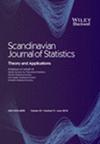Discussion on the SJS invited paper by Sander Greenland Divergence vs. Decision P$$ P $$‐values: A Distinction worth making in theory and keeping in Practice
IF 1
4区 数学
Q3 STATISTICS & PROBABILITY
引用次数: 0
Abstract
It is shown in the cited paper written by Michael Lavine and in several others works that the p -value of the test-statistics is not a consistent measure of evidence in the context of testing alternative hypothesis. As Sander Greenland points out, these should not be confused with the p -values of realized goodness of-fit-test statistics. Goodness-of-fit tests are useful sanity checks in order to decide, (and there would be also a decision to be taken there !) whether our model and/or assumptions are compatible with the available data, or we need to take a step back and look for what could be wrong. Greenland argues that although using the p -value in a goodness of fit test violates the likelihood principle, these p -values do not suffer the inconsistencies of p -values arising from testing alternative hypothesis, and can be used as a measure of evidence against the model, (following Popper, scientific theories and models can be only falsified and never verified), on an absolute scale in the [ 0 , 1 ] range, where a zero left-sided p -value corresponds to perfect fit, and every p -value strictly greater than zero should be considered as negative evidence of some level. I find this peculiar, unless we would be dealing only with fully deterministic models. Fitting the data is not对Sander Greenland的SJS邀请论文的讨论分歧与决策P $$ P $$‐values:一个值得在理论上做出并在实践中保持的区别
Michael Lavine所引用的论文和其他几部作品表明,在检验替代假设的背景下,检验统计的p值并不是证据的一致度量。正如Sander Greenland所指出的,这些不应与已实现的拟合优度检验统计数据的p值相混淆。拟合优度检验是一种有用的完整性检查,用于判断我们的模型和/或假设是否与可用数据兼容,或者我们需要退后一步,寻找可能出错的地方。格陵兰岛认为,尽管使用的p值拟合优度试验违反了可能性原则,这些p值不受p值的不一致引起的测试替代假说,并可以用作衡量证据的模型,(波普尔后,科学理论和模型只能伪造和未曾得到证实),在一个绝对标度在[0,1]区间,在零奔袭p值对应于完美的配合,每一个严格大于零的p值都被认为是某种程度上的负证据。我觉得这很奇怪,除非我们只处理完全确定的模型。拟合数据则不然
本文章由计算机程序翻译,如有差异,请以英文原文为准。
求助全文
约1分钟内获得全文
求助全文
来源期刊

Scandinavian Journal of Statistics
数学-统计学与概率论
CiteScore
1.80
自引率
0.00%
发文量
61
审稿时长
6-12 weeks
期刊介绍:
The Scandinavian Journal of Statistics is internationally recognised as one of the leading statistical journals in the world. It was founded in 1974 by four Scandinavian statistical societies. Today more than eighty per cent of the manuscripts are submitted from outside Scandinavia.
It is an international journal devoted to reporting significant and innovative original contributions to statistical methodology, both theory and applications.
The journal specializes in statistical modelling showing particular appreciation of the underlying substantive research problems.
The emergence of specialized methods for analysing longitudinal and spatial data is just one example of an area of important methodological development in which the Scandinavian Journal of Statistics has a particular niche.
 求助内容:
求助内容: 应助结果提醒方式:
应助结果提醒方式:


